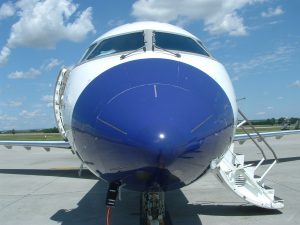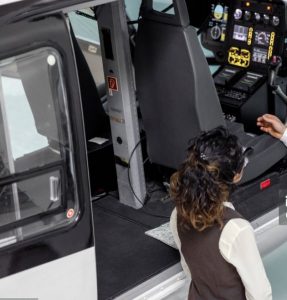Open Artificial Intelligence In Pilot Training
 In recent years, the aviation industry has witnessed a remarkable shift with the integration of artificial intelligence into various aspects of flight operations. From flight simulations to predictive maintenance, AI is transforming how pilots are trained, improving safety, efficiency, and overall performance. One of the most significant developments in this area is the use of open artificial intelligence in pilot training programs. Open AI refers to AI systems, algorithms, and tools that are accessible to the public, allowing developers, educators, and companies to modify, share, and adapt them for different purposes. In the context of pilot training, open AI represents an exciting frontier that can make aviation training more adaptive, cost-effective, and engaging.
In recent years, the aviation industry has witnessed a remarkable shift with the integration of artificial intelligence into various aspects of flight operations. From flight simulations to predictive maintenance, AI is transforming how pilots are trained, improving safety, efficiency, and overall performance. One of the most significant developments in this area is the use of open artificial intelligence in pilot training programs. Open AI refers to AI systems, algorithms, and tools that are accessible to the public, allowing developers, educators, and companies to modify, share, and adapt them for different purposes. In the context of pilot training, open AI represents an exciting frontier that can make aviation training more adaptive, cost-effective, and engaging.
In this article, we will explore how open artificial intelligence is being utilised in pilot training, its benefits, challenges, and the future potential of AI-driven training programs in aviation.
Open artificial intelligence
Open artificial intelligence, at its core, refers to AI models, software frameworks, and tools that are publicly available for use and modification. Unlike proprietary AI systems that are restricted by licenses or patents, open AI is freely accessible, allowing users to build upon existing technologies and create innovative solutions. The open-source nature of AI allows developers, educators, and organizations to collaborate, share knowledge, and continuously improve upon existing systems.
Popular open AI frameworks like TensorFlow, PyTorch, and OpenAI’s GPT have already seen widespread use in various industries. In aviation, open AI can be used in flight simulation systems, intelligent tutoring platforms, data analysis, and even for real-time decision-making assistance during flight training exercises.
Role of AI in pilot training
Pilot training is a critical part of ensuring safety and competence in aviation. It requires an intricate combination of technical skills, decision-making, situational awareness, and the ability to respond quickly to unexpected situations. Traditionally, pilot training involved a blend of classroom instruction, flight simulators, and hands-on flight hours with an instructor.
AI-driven pilot training systems are enhancing these traditional methods, providing more efficient, personalized, and effective learning experiences. By leveraging machine learning algorithms, natural language processing, and advanced data analytics, open AI can create training programs that are not only more dynamic but also capable of adapting to the unique needs of individual pilots.
AI-powered flight simulations
Flight simulators have long been a cornerstone of pilot training, allowing trainees to practice flight maneuvers and emergency procedures in a controlled environment. Open AI takes flight simulation to the next level by making these systems smarter, more responsive, and capable of adapting to the trainee’s abilities.
AI-enhanced flight simulators can adjust the level of difficulty in real time, offering personalized training based on the trainee’s progress. If a student struggles with certain maneuvers or decision-making tasks, the system can provide additional guidance and practice scenarios tailored to those areas. Conversely, for experienced pilots, the system can increase the complexity of simulations, helping them refine their skills under more challenging conditions.
Moreover, AI can help analyze a trainee’s performance during simulations, providing detailed feedback on their decision-making, timing, and control techniques. This feedback can be used to create customised learning paths that target areas for improvement, increasing the efficiency of training sessions.
Intelligent tutoring systems
The most exciting application of open AI in pilot training is the development of intelligent tutoring systems. These AI-powered platforms use machine learning algorithms to assess a trainee’s performance and provide personalized instruction. Unlike traditional training methods, which typically follow a fixed curriculum, intelligent tutoring systems can adapt to the specific needs and progress of each pilot.
Open AI allows these tutoring systems to access vast amounts of aviation data, including flight manuals, weather reports, and real-time flight data, which they can use to offer contextually relevant feedback. For example, if a trainee encounters a particular challenge during a simulated flight, the system can offer targeted advice on how to overcome the issue, incorporating real-world data to suggest appropriate solutions.
Moreover, intelligent tutoring systems can offer a more interactive and engaging learning experience. By simulating realistic scenarios and providing immediate, personalised feedback, these systems can help pilots retain critical information and improve their skills faster than traditional methods.
AI for performance analysis and feedback
The most powerful use of open AI in pilot training is its ability to analyze vast amounts of performance data and provide detailed feedback. With the help of machine learning algorithms, AI systems can track a pilot’s progress, detect patterns in their performance, and identify areas where improvement is needed.
For example, AI can analyze data from flight simulators, real-time flight data, and even physiological sensors (such as heart rate monitors) to provide a comprehensive picture of a trainee’s performance. This data can be used to assess decision-making processes, reaction times, and stress management under various conditions. It also helps in recognizing trends, such as whether a trainee consistently struggles with certain tasks, allowing instructors to intervene and offer targeted guidance.
This performance analysis can be presented in an easily understandable format, with graphs, charts, and detailed reports that highlight strengths and areas for improvement. By integrating this AI-powered feedback into regular training, pilots can see their development in real time, allowing for more efficient and focused learning.
Benefits of open AI in pilot training
The integration of open AI into pilot training brings a wide array of benefits that enhance both the quality and efficiency of the training process. Here are some of the key advantages:
1) Personalisation of training
AI’s ability to adapt to the individual learning pace and style of each trainee is one of its most significant advantages. Every pilot learns differently, and some may struggle with specific areas such as navigation, communication, or emergency procedures. Open AI-driven systems can personalize the training experience, tailoring the curriculum to focus on areas where the trainee needs the most improvement.
2) Cost-effectiveness
Training pilots can be a costly endeavor, particularly when it comes to flight hours and the use of high-end simulators. Open AI helps reduce costs by optimizing the use of simulators, improving efficiency in training programs, and providing more flexible learning options. AI-powered simulations can be run on-demand, without the need for a physical aircraft or a human instructor present. This makes training more accessible and cost-effective, particularly for smaller flight schools or emerging markets.
3) Improved safety
Safety is the top priority in aviation, and AI plays a crucial role in improving it. By enabling pilots to train in a variety of high-risk scenarios, AI-powered systems can ensure that pilots are prepared for almost any situation. Open AI systems can simulate hazardous weather conditions, system failures, and emergency situations that would be difficult or unsafe to replicate in a traditional training environment.
Furthermore, AI can help identify patterns in pilot performance that may indicate safety concerns. For instance, if a trainee repeatedly fails to make crucial decisions in emergency scenarios, AI can flag these patterns for review by the instructor, allowing for early intervention and correction.
4) Real-time feedback and continuous learning
Open AI systems are capable of providing immediate, real-time feedback, which helps pilots to correct mistakes on the spot and improve their performance during training. Unlike traditional methods, where feedback may only be given after a session, AI can provide continuous learning opportunities by monitoring and adjusting the training process in real-time.
This continuous feedback loop promotes faster learning and reinforces correct behaviours, leading to more confident and competent pilots.
Challenges of implementing open AI in pilot training
While the potential of open AI in pilot training is immense, there are still several challenges to overcome in fully integrating these systems into the aviation training ecosystem. Some of these challenges include:
1) Data privacy and security concerns
AI systems rely on large amounts of data to function effectively, including sensitive information about pilot performance and training progress. Ensuring the privacy and security of this data is a critical concern, especially when working with open AI platforms that may have vulnerabilities.
To address these concerns, training organisations must implement robust data protection measures, including encryption, secure storage, and strict access controls, to prevent unauthorised access and data breaches.
2) Integration with existing training systems
Many flight schools and aviation academies already use traditional methods of pilot training, such as instructor-led lessons, classroom sessions, and physical simulators. Integrating open AI technologies into these existing systems can be challenging, requiring investment in new technologies and staff training.
Furthermore, aligning AI systems with established regulatory frameworks and certification standards in aviation can also be a time-consuming process, as aviation authorities may need to evaluate and approve AI-based training methods.
3) Dependence on technology
While AI offers numerous benefits, over-reliance on automated systems could potentially lead to a lack of fundamental piloting skills. In particular, trainees may become overly reliant on AI-driven systems for decision-making and performance analysis, which could undermine their ability to handle unexpected situations without technological assistance.
To mitigate this risk, AI should be used as a supplement to, rather than a replacement for, traditional pilot training methods. Human instructors must still play a vital role in guiding pilots through complex scenarios and ensuring that they develop strong foundational skills.
Future of open AI in pilot training
The future of open AI in pilot training is incredibly promising. As AI technology continues to evolve, it will become even more sophisticated, capable of providing increasingly realistic simulations, more accurate performance analysis, and even better personalized learning experiences. Integration with other emerging technologies, such as virtual reality and augmented reality, could further enhance the realism of flight training environments.
Moreover, AI’s ability to analyze vast amounts of data in real-time will enable more proactive, predictive training methods. For instance, AI could monitor a trainee’s progress over time and predict areas where they may struggle in the future, allowing instructors to address these issues before they become significant problems.
In conclusion, open AI has the potential to significantly revolutionize pilot training, offering personalized, cost-effective, and efficient solutions that improve both the quality and safety of aviation education. As the technology continues to advance, it is likely that AI will become an integral part of the pilot training process, helping to create a new generation of highly skilled, adaptive, and safe pilots.










